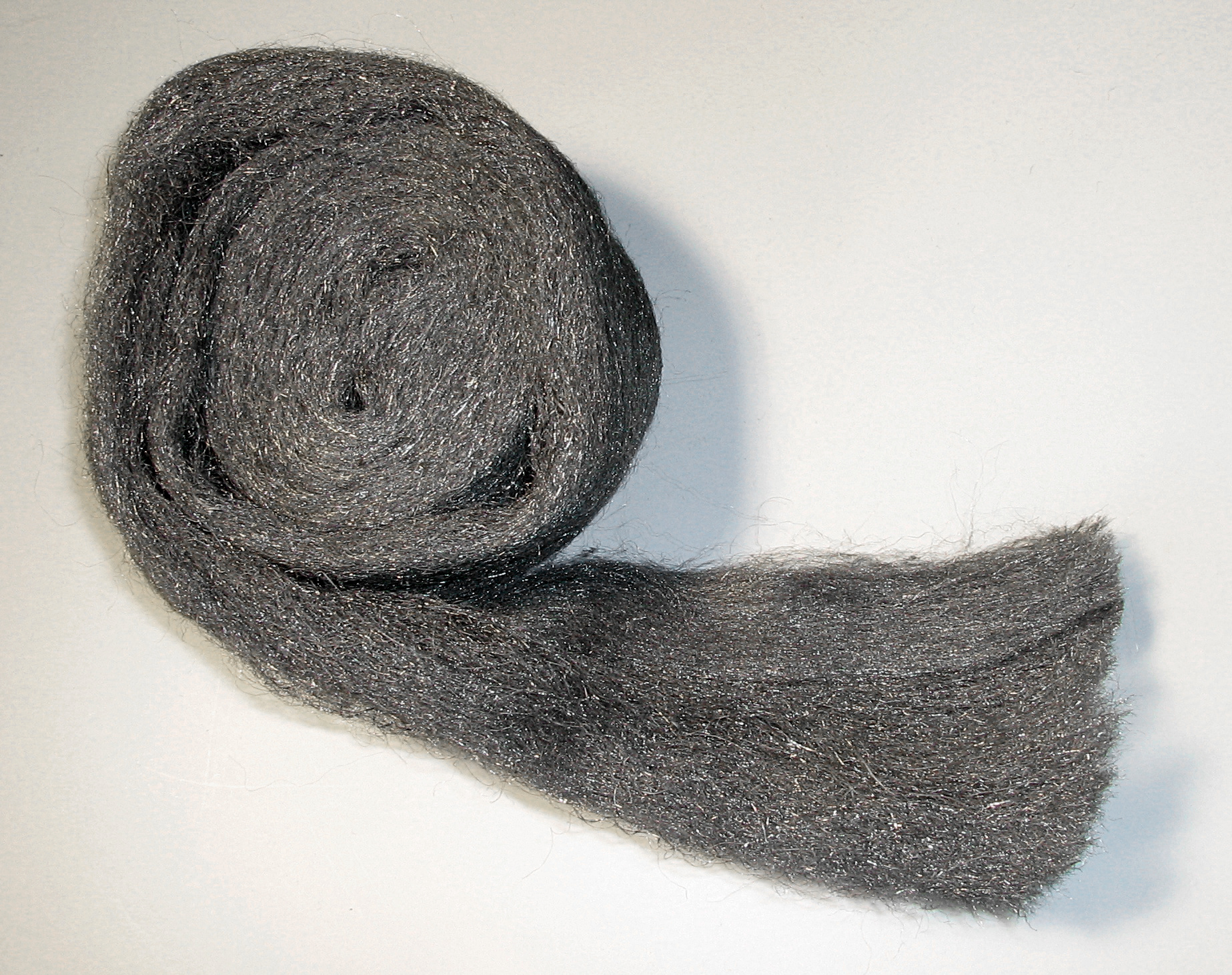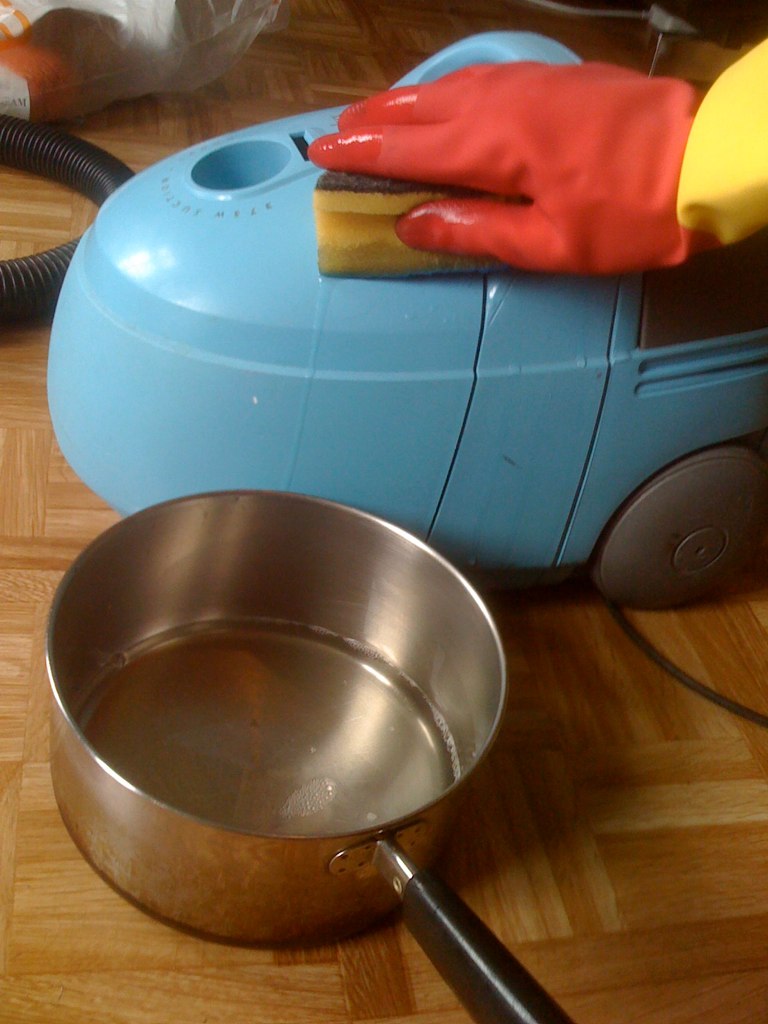|
Scotch-Brite
Scotch-Brite is a line of abrasive products produced by 3M. The product line includes scouring pads and tools for home uses such as dish washing and scrubbing, as well as various types of surfaces for industrial applications, such as discs, belts, and rotating brushes, with varying compositions and levels of hardness. The structure of Scotch-Brite pads is created by a sparse unwoven polymer such as cellulose, nylon or spun polypropylene fiber. Products use several variations of hardening and abrasive materials, such as aluminum oxide (alumina), titanium dioxide and resins. Although the base polymers may be considered benignly soft, the composition with other materials greatly enhances their abrasive powers; to the extent that a heavy-duty Scotch-Brite pad (which contains both aluminum oxide and titanium dioxide) will scratch glass. History Scotch-Brite was introduced during the 1950s. Development continues into the 21st century with new products for various cleaning uses. Scotc ... [...More Info...] [...Related Items...] OR: [Wikipedia] [Google] [Baidu] |
Scouring Pad
A scouring pad or scourer is a small pad of metal or plastic mesh used for scouring a surface. Some scouring pads have one side made of a soft sponge-like material and the other is the aforementioned mesh. History The scouring pad has been reincarnated in several forms over the years. In 1928, R. B. Kingman patented the scouring ball, which was one of the first scouring pads made of a metal mesh. On 30 September 1941United States patent 2,257,456was issued to Joseph R. Crockford of Chicago, IL for a scouring device of the type employed for "cleansing and scouring pots, pans and other household implements." The invention provided for a "plate of non-corrosive metal, arched or curved to fit the fingers." In 1942, David J. Kelman patented a toroidal metal scouring pad. This was, and still is, used as an abrasive scrubbing pad, however, it is becoming less common, as it removes non-stick surfaces off pans. On June 19, 1962, Alfred Benjamin patented the stainless-steel scouring p ... [...More Info...] [...Related Items...] OR: [Wikipedia] [Google] [Baidu] |
Bronze Wool
Bronze wool is a bundle of very fine bronze filaments , used in finishing and repair work to polish wood or metal objects. Niemeyer, Shirley (1994). "NF94-139 Preservation of Metal Items". Historical Materials from University of Nebraska-Lincoln Extension. Bronze wool is similar to steel wool, but is used in its place to avoid some problems associated with broken filaments: steel rusts quickly, especially in a marine environment. Furthermore, steel is magnetic and can affect the operation of marine equipment, such as a compass. Steel can also discolor some materials, such as oak. This discoloration results from a reaction between the tannates in the oak and the iron in the steel, forming iron tannate, a black compound. Bronze wool also has uses for filter elements, again when rusting would be a problem. The main US retail supplier of bronze wool is Homax Group, under their Rhodes American brand. Bronze wool has largely been replaced for cost reasons, by plastic mesh abrasives ... [...More Info...] [...Related Items...] OR: [Wikipedia] [Google] [Baidu] |
95 105 Scotch Brite (155385643)
95 or 95th may refer to: * 95 (number) * one of the years 95 BC, AD 95, 1995, 2095, etc. * 95th Division (other) * 95th Regiment ** 95th Regiment of Foot (other) * 95th Squadron (other) * Atomic number 95: americium *Microsoft Office 95 * Saab 95 * Windows 95 See also * 9 to 5 (other) 9 to 5, or working time, is the standard period of working hours for some employees. 9 to 5 or Nine to Five may also refer to: Film and television * ''9 to 5'' (film), a 1980 American comedy film ** ''9 to 5'' (soundtrack) * ''9 to 5'' (TV ser ... * * List of highways numbered {{Numberdis ... [...More Info...] [...Related Items...] OR: [Wikipedia] [Google] [Baidu] |
Cellulose
Cellulose is an organic compound with the formula , a polysaccharide consisting of a linear chain of several hundred to many thousands of β(1→4) linked D-glucose units. Cellulose is an important structural component of the primary cell wall of green plants, many forms of algae and the oomycetes. Some species of bacteria secrete it to form biofilms. Cellulose is the most abundant organic polymer on Earth. The cellulose content of cotton fiber is 90%, that of wood is 40–50%, and that of dried hemp is approximately 57%. Cellulose is mainly used to produce paperboard and paper. Smaller quantities are converted into a wide variety of derivative products such as cellophane and rayon. Conversion of cellulose from energy crops into biofuels such as cellulosic ethanol is under development as a renewable fuel source. Cellulose for industrial use is mainly obtained from wood pulp and cotton. Some animals, particularly ruminants and termites, can digest cellulose with the help of ... [...More Info...] [...Related Items...] OR: [Wikipedia] [Google] [Baidu] |
Nylon
Nylon is a generic designation for a family of synthetic polymers composed of polyamides ( repeating units linked by amide links).The polyamides may be aliphatic or semi-aromatic. Nylon is a silk-like thermoplastic, generally made from petroleum, that can be melt-processed into fibers, films, or shapes. Nylon polymers can be mixed with a wide variety of additives to achieve many property variations. Nylon polymers have found significant commercial applications in fabric and fibers (apparel, flooring and rubber reinforcement), in shapes (molded parts for cars, electrical equipment, etc.), and in films (mostly for food packaging). History DuPont and the invention of nylon Researchers at DuPont began developing cellulose based fibers, culminating in the synthetic fiber rayon. DuPont's experience with rayon was an important precursor to its development and marketing of nylon. DuPont's invention of nylon spanned an eleven-year period, ranging from the initial research pr ... [...More Info...] [...Related Items...] OR: [Wikipedia] [Google] [Baidu] |
Polypropylene
Polypropylene (PP), also known as polypropene, is a thermoplastic polymer used in a wide variety of applications. It is produced via chain-growth polymerization from the monomer propylene. Polypropylene belongs to the group of polyolefins and is partially crystalline and non-polar. Its properties are similar to polyethylene, but it is slightly harder and more heat-resistant. It is a white, mechanically rugged material and has a high chemical resistance. Bio-PP is the bio-based counterpart of polypropylene (PP). Polypropylene is the second-most widely produced commodity plastic (after polyethylene). In 2019, the global market for polypropylene was worth $126.03 billion. Revenues are expected to exceed US$145 billion by 2019. The sales of this material are forecast to grow at a rate of 5.8% per year until 2021. History Phillips Petroleum chemists J. Paul Hogan and Robert Banks first demonstrated the polymerization of propylene in 1951. The stereoselective polymerization t ... [...More Info...] [...Related Items...] OR: [Wikipedia] [Google] [Baidu] |
Titanium Dioxide
Titanium dioxide, also known as titanium(IV) oxide or titania , is the inorganic compound with the chemical formula . When used as a pigment, it is called titanium white, Pigment White 6 (PW6), or CI 77891. It is a white solid that is insoluble to water, although mineral forms can appear black. As a pigment, it has a wide range of applications, including paint, sunscreen, and food coloring. When used as a food coloring, it has E number E171. World production in 2014 exceeded 9 million tonnes. It has been estimated that titanium dioxide is used in two-thirds of all pigments, and pigments based on the oxide have been valued at a price of $13.2 billion. Structure In all three of its main dioxides, titanium exhibits octahedral geometry, being bonded to six oxide anions. The oxides in turn are bonded to three Ti centers. The overall crystal structure of rutile is tetragonal in symmetry whereas anatase and brookite are orthorhombic. The oxygen substructures are all slight distort ... [...More Info...] [...Related Items...] OR: [Wikipedia] [Google] [Baidu] |
Steel Wool
Steel wool, also known as iron wool, wire wool or wire sponge, is a bundle of very fine and flexible sharp-edged steel filaments. It was described as a new product in 1896.''Iron Age'', Vol. LVII, p.871, cited by ''Journal of the Iron and Steel Institute'', Volume 50, Issue 2, p.48/ref> It is used as an abrasive in finishing and repair work for polishing wood or metal objects, cleaning household cookware, cleaning windows, and sanding surfaces. Steel wool is made from low-carbon steel in a process similar to broaching, where a heavy steel wire is pulled through a toothed die that removes thin, sharp, wire shavings. Uses Steel wool is commonly used by woodworkers, metal craftsmen, and jewelers to clean and smooth working surfaces and give them shine. However, when used on oak, remaining traces of iron may react with tannins in the wood to produce blue or black iron stain, and when used on aluminum, brass, or other non-ferrous metal surfaces may cause after-rust which will du ... [...More Info...] [...Related Items...] OR: [Wikipedia] [Google] [Baidu] |
Cleaning Products
Cleaning agents or hard-surface cleaners are substances (usually liquids, powders, sprays, or granules) used to remove dirt, including dust, stains, bad smells, and clutter on surfaces. Purposes of cleaning agents include health, beauty, removing offensive odor, and avoiding the spread of dirt and contaminants to oneself and others. Some cleaning agents can kill bacteria (e.g. door handle bacteria, as well as bacteria on worktops and other metallic surfaces) and clean at the same time. Others, called degreasers, contain organic solvents to help dissolve oils and fats. Chemical agents Acidic Acidic cleaning agents are mainly used for removal of inorganic deposits like scaling. The active ingredients are normally strong mineral acids and chelants. Often, surfactants and corrosion inhibitors are added to the acid. Hydrochloric acid is a common mineral acid typically used for concrete. Vinegar can also be used to clean hard surfaces and remove calcium deposits that also helps to m ... [...More Info...] [...Related Items...] OR: [Wikipedia] [Google] [Baidu] |
.jpeg/1200px-95_105_Scotch_Brite_(155385643).jpeg)



